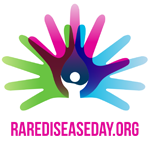
The zebra is used as a symbol for rare diseases since about 1940.
This comes from a quote by Dr. Theodore Woodward: “When you hear hoofbeats, think horses, not zebras.” and “When you hear hoofbeats behind you, don’t expect to see a zebra.”
This is the metaphor Dr. Woodward used to teach students basic concepts about the diagnosis of disease: when examining a patient’s symptoms, it’s better to think of a horse rather than a zebra. It’s a fact that horses are hoofed animals more commonly encountered than zebras, so you should automatically assume that if you hear the sound of hooves, it should be a horse, not a zebra, right?
The national awareness day is on February 29, a date that’s only on the calendar every four years. (It’s moved to February 28 on non-leap years.)
The day was started by the European Organisation for Rare Diseases and is now recognized globally. The symbol for rare disease awareness is a zebra-striped ribbon.

Statistics and facts
Here are a few statistics and facts to illustrate the breadth of the rare disease problem worldwide.
- There are approximately 7,000 rare diseases and disorders, with more being discovered each day. https://globalgenes.org/rarelist/
- It is estimated that 350 million people worldwide suffer from rare diseases
- If all of the people with rare diseases lived in one country, it would be the world’s 3rd most populous country. In Quebec, it is estimating that close to one in 20 people will be affected or have a rare disease, which means nearly 500,000 Quebeckers.
- 80% of rare diseases are genetic in origin, and thus are present throughout a person’s life, even if symptoms do not immediately appear.
- It can take several years to diagnose a rare disease. Many rare diseases have nonspecific symptoms such as pain, weakness, and dizziness, which can make them hard to diagnose.
- Rare diseases can also be hard to diagnose because they’re unusual. Your doctor may never have seen a similar case and may not even realize a specific disease exists.
- Besides, it could take weeks or months for you to get an appointment with a specialist. Then, if that specialist was not the right one, you might wait months before seeing the next one. Patients with rare diseases visit more than seven doctors on average before receiving an accurate diagnosis, according to a 2013 study published in the Journal of Rare Disorders.
- Approximately 50% of the people affected by rare diseases are children.
- 30% of children with rare disease will not live to see their 5th birthday
- Rare diseases are responsible for 35% of deaths in the first year of life.
- Newborn screening for rare diseases is recommended. Screening requirements for newborns vary by country, but they’re increasingly becoming routine.
- Even without a cure for a particular condition, early diagnosis is essential to prevent death or disability and to help children reach their full potential.
- Genetic testing can help diagnose many rare diseases, but not all. Genetic testing identifies a genetic cause in an estimated 25 percent to 30 percent of cases.
- Only 5 percent of rare diseases have treatments. Drug research that helps a limited number of people can be cost-prohibitive for pharmaceutical companies.
Finding a support group is important
A rare disease can be isolating for the patient as well as for the caregiver, especially when it’s your child who has the condition.
Connecting with others can be essential, not only for support but also to share information and resources.






